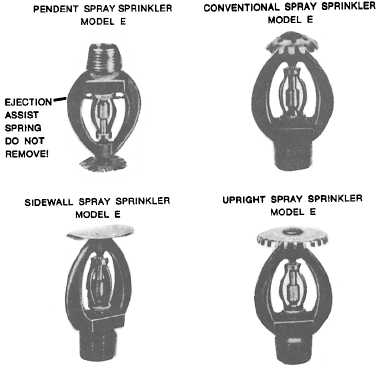A frangible pellet sprinkler (fig. 8-16) has a rod between the orifice cap and sprinkler frame. The rod is held in place by a pellet of solder under compression. When the solder melts, the rod moves out of the way of the orifice cap. The cap is pushed off by the water pressure in the piping network.
The bimetallic element sprinkler (fig. 8-17) uses a disk made of two distinct metals as a heat- sensitive element. When the sprinkler is off, the disk maintains pressure on a piston assembly. When a fire occurs and the temperature reaches the sprinkler's rating, the disk flexes and opens, releasing pressure on the piston assembly and allowing a small amount of water to bleed out of the piston chamber faster than it can be replaced through a restrictor. The water pressure in the piping network pushes the piston down and allows water to discharge from the sprinkler. When the temperature of the heat-sensitive element is reduced, the element returns to its normal position and allows water to pass through the restrictor, filling up the piston chamber, forcing the piston into the closed position, and stopping water discharge. This sprinkler can be used to automatically cycle on and off as necessary; for example, to put out a rekindled fire.
Other sprinkler heads that do not have release mechanisms include the dry pendent sprinkler, the open sprinkler, and water spray nozzles.

Figure 8-17. - Bimetallic element automatic sprinkler.

Figure 8-16. - Frangible pellet automatic sprinkler.
Continue Reading